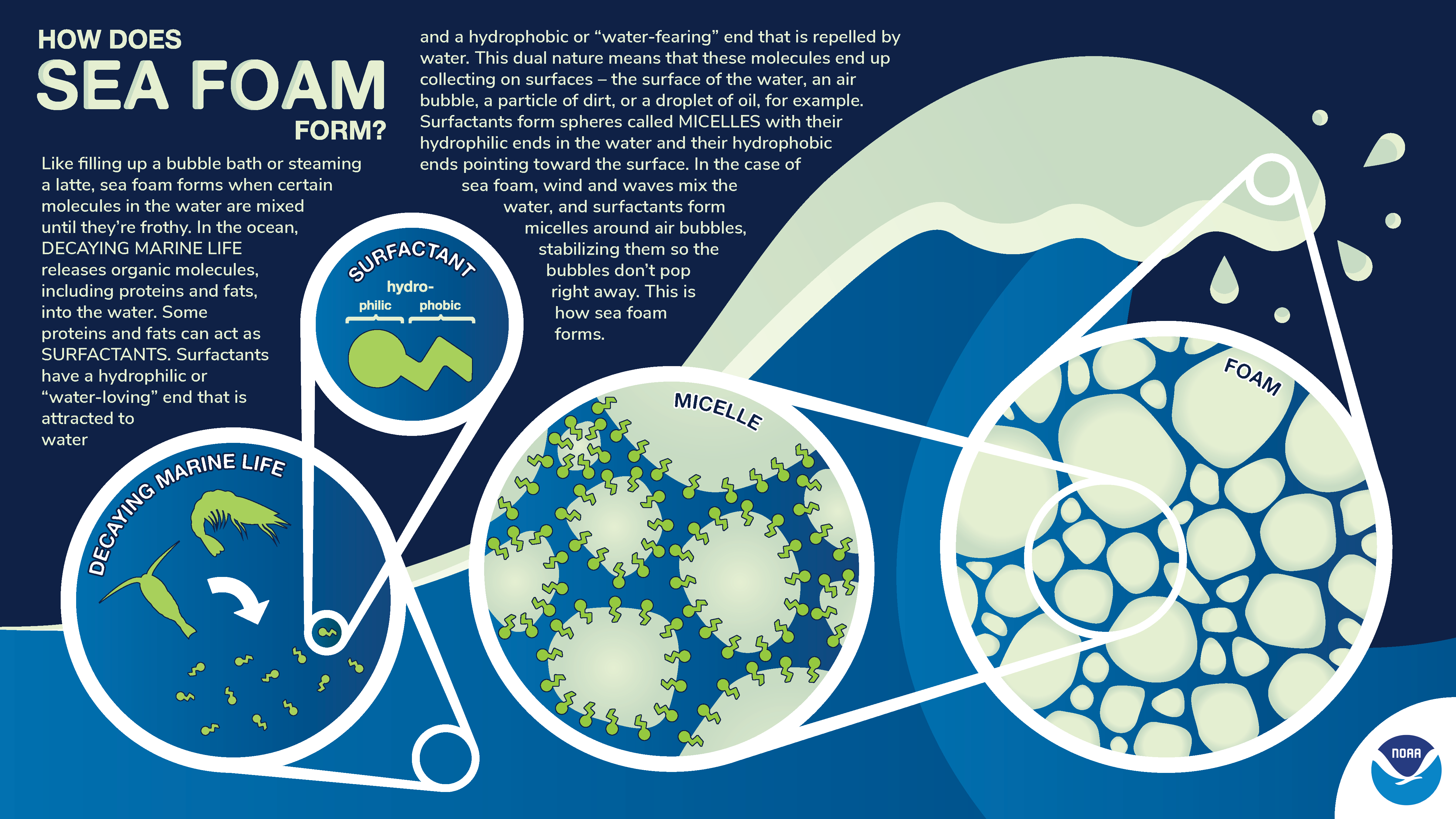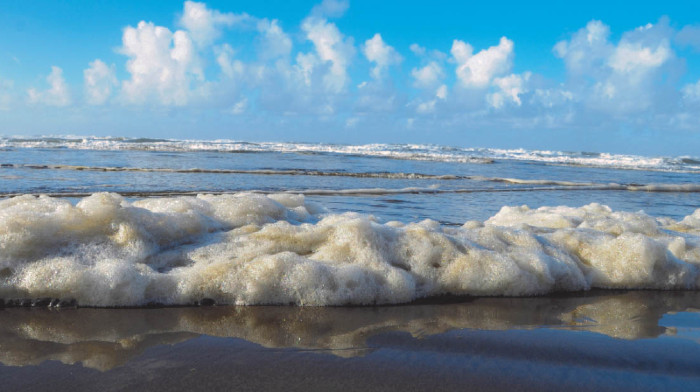Depending on where you are on the beach, you may notice some remaining foamy particles that cling to the sand as the waves smash against the shore or wash at the beach. Sometimes that foam could be enormous amounts that worry beachgoers and seaside communities. What is Sea Foam Made Of
Sea Foam contains dissolved salts, proteins, fats, dead algae, detergents, and other pollutants, and a bunch of other bits and pieces of organic and artificial matter. If you shake this glass of ocean water vigorously, small bubbles will form on the surface of the liquid.
Algal blooms are one common source of thick sea foams. When large blooms of algae decay offshore, great amounts of decaying algal matter often wash ashore. Foam forms as this organic matter is churned up by the surf.
Introduction:
So, seafoam is a mechanical and chemical phenomenon caused by two key factors: large swells or storms and high concentrations of organic debris in seawater. The creation of sea foam is similar to the formation of sea spray; both are caused by the breaking of waves. However, the formation of sea spray is not dependent on the presence of biological materials. Lets take a look hoe Sea Foam is formed and what it’s made of.
What Foam Formed from Dissolved Organic Matter in the Ocean Is Made Of
Have you ever strolled along the beach and observed the whimsical dance of sea foam made of myriad ocean elements? This frothy, white lathery substance, also known as ocean foam, is more than meets the eye. Let’s delve into the intricacies of what makes up this seemingly soap-like foam, an intriguing concoction crafted by Mother Nature herself. Much like the airy, festive bubbles from a shaken bottle of champagne, sea foam is born from the agitation of seawater, where waves meet the shore with a vivacious energy.

At the core, sea foam formed of organic matter and marine residues unveils its secret ingredients to curious minds.
Decaying marine life, a rich tapestry of proteins and lipids, lends itself to this foamy artistry.
When the bustling ocean stirs these components fiercely, a process not unlike whipping egg whites into peaks, it entraps air bubbles in a mesmerizing display of sea foam. But the organic matter is a mere part of an elaborate recipe.
Plants of the sea, like the diverse family of algal blooms, also contribute to the foam chemical profile. During their life cycle, they release surfactants – substances that lower the surface tension of water, much like the detergents we use at home, aiding in foam form creation.
Now, one can’t muse about sea foam without giving a nod to the science behind it. It’s here that entities like the National Oceanic and Atmospheric Administration (NOAA) provide valuable insights.
Through rigorous studies, NOAA has shed light upon how exactly this marine foam is made from such a blend of nutrients and organic debris. Surfactants, released by everything from phytoplankton to decaying seaweed, are key players in the foam, ensuring the longevity and stability of those captivating white caps that crown the waters’ edges.
As one gazes upon the sea foams lining our shores, a thought may arise: This is similar to the suds from soap. Indeed, the foam formed by the ocean shares parallels with our everyday cleaning aids, thanks to surfactants.
These crucial foam agents are omnipresent – in the soap, we use to scrub our skin and the natural foam we admire in the wild blue sea. However, the organic matter that underpins the seemingly endless swathes of sea foam is distinctly natural, offering a glimpse into the marine life’s cycle and its conclusion.
It’s fascinating how these elements conspire to create foam foams that serve as tell-tale signs of the ocean’s health and activities beneath the waves. While sea foam is often a natural occurrence, excessive foam can sometimes indicate issues like pollution or excessive nutrients from run-off, culminating in unusual algal blooms. Therefore, it’s essential to understand what sea foam is made of, for it reflects the story of marine environments, beautifully complex and delicately balanced.
In sum, the next time you find yourself marveling at the foam unfurling onto the sand, remember you’re witnessing a tale as old as the sea itself. Each bubble, every patch of lather, is a part of the depths made of life’s final act and nature’s persistent churn. It’s a soap-like foam that cleanses more than our feet – it offers a rinse of wonder, science, and respect for the marine story that unfolds beneath the surface of our treasured oceans.
Is Sea Foam Harmful? Assessing the Impacts of Marine Foam and Organic Matter Bubbles on Beachgoers
When beachgoers venture forth for a day of sun-kissed leisure, they’re often greeted by the frothy embrace of sea foam. This whimsical foam, made largely of organic matter, may appear as a carefree hallmark of the ocean’s vast mysteries, yet the question remains: is foam harmful?

This extensive exploration invites us to wade through the science behind these marine bubbles and assess how seafoam may influence coastal life. On the surface, sea foam paints a portrait of the ocean’s organic productivity, bubbled up from the churn of marine waters.
Fundamentally, it is composed of dissolved organic matter – remnants of life that once lived through the ocean depth. But don’t let the spectacle distract from the eco-tale it tells; these bubbles provide a beachfront education about the interconnected workings of our planet’s blue heart.
Those white caps of foam that lace the beach shores are storytellers of the ocean’s condition. Often, these marine bubbles are benign, products of the natural cycle where organic matter dances with the sea’s undulating work.
But can sea foam be harmful? Under certain conditions, like when algal blooms run amok, sea foam may bring more to the shore than meets the eye – a potpourri of decomposing algae and often, a smattering of pollutants washed out of human reach. In these cases, sea foam can trap toxins and bring them to the beach, potentially impacting both seabirds and humans.
Sea foam is generally not harmful, but it’s important to consider the context and potential factors that may affect its safety. Here’s a list of considerations:
Conclusion:
Sea foam is generally not harmful in its natural state, often occurring as a result of natural processes in coastal areas. However, caution is necessary, especially when sea foam is influenced by human-made factors, pollutants, or algal blooms. The safety of sea foam depends on the water quality and environmental conditions. It is crucial to stay informed about local conditions, particularly in areas prone to pollution, to ensure the foam does not contain harmful substances. Additionally, individuals with compromised immune systems should take precautions when interacting with sea foam to minimize any potential risks.
References:
NOAA Home Page – NOAA
FAQ’s
Q: What exactly is sea foam, and what causes it to form on beaches?
A: Sea foam is a frothy white substance that appears along the shoreline, primarily made of dissolved organic matter from decaying marine life, like a mix of proteins, lipids, and a family of algal blooms. It forms when the ocean’s waves, containing these organic materials and surfactants released by marine organisms, agitate the water, trapping air and creating bubbles similar to whipping egg whites.
Q: Are the sea foam components similar to the soap ingredients?
A: Yes, there’s a similarity. Sea foam contains natural surfactants released by marine life such as phytoplankton, which lower the surface tension of water, much like the surfactants found in soap. Though soap is usually a man-made product, both sea foam and soap share the commonality of having ingredients that can create lather or bubbles.
Q: Can sea foam be harmful to people or marine life?
A: While sea foam is often seen as a whimsical and natural part of the beach experience, it can sometimes be harmful. Excessive foam can indicate pollution or an overabundance of nutrients, resulting in abnormal algal blooms. Some of this foam might trap toxins and pollutants, which can affect marine life, seabirds, and potentially humans.
Q: Is sea foam always indicative of ocean pollution?
A: Not necessarily. Many occurrences of sea foam are a natural and benign part of the ocean’s ecosystem, simply reflecting the ocean’s organic productivity. However, it is essential to monitor the composition and frequency of sea foam, as increased levels can sometimes reveal underlying environmental issues such as pollution.
Q: How does sea foam contribute to our understanding of the ocean’s health?
A: Sea foam can serve as an indicator of the ocean’s overall health and activity. By studying the contents and frequency of sea foam, scientists and organizations like NOAA can gauge the level of organic matter and surfactants in the water, which may suggest things about marine life cycles, the presence of pollutants, or the effects of human activity on marine ecosystems.



